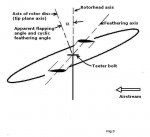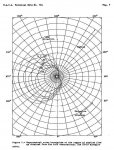MichaelBurton
Gyro CFI
- Joined
- Oct 2, 2004
- Messages
- 1,261
- Location
- Petaluma CA. USA
- Aircraft
- Sparrowhawk, B95, AC680, BE23, Calidus, MTO Sport, Cavalon, Vortex, Dominator, WindRyder, RAF2000
- Total Flight Time
- 6000+ over 3000 hrs in gyro
Michael, so would you say that a gyro with a slightly smaller blade length than should be, say all up weight 500lb with 22 ft Bensen blade, could flap, after a high speed decent (say 85mph) followed by a hard bank?
The blades always flap. What you want to know is if this will cause a problem for your gyro. I can not say. The thing is every "Benson" is different. different blade length, different weight, different head design. Each of these things are important when we consider the dangers of the big blade flap at high speed.
The hard turn will probably decrease the flapping motion as it will add G force to the gyro increasing the load that the rotor is under. This will increase the lift generated and the speed that the rotor turns.
I don't think that 85mph is fast enough to cause the problem. But again it is dependant on the design.



